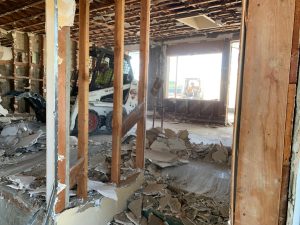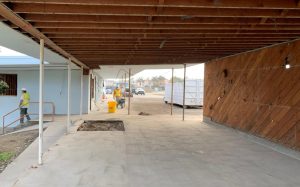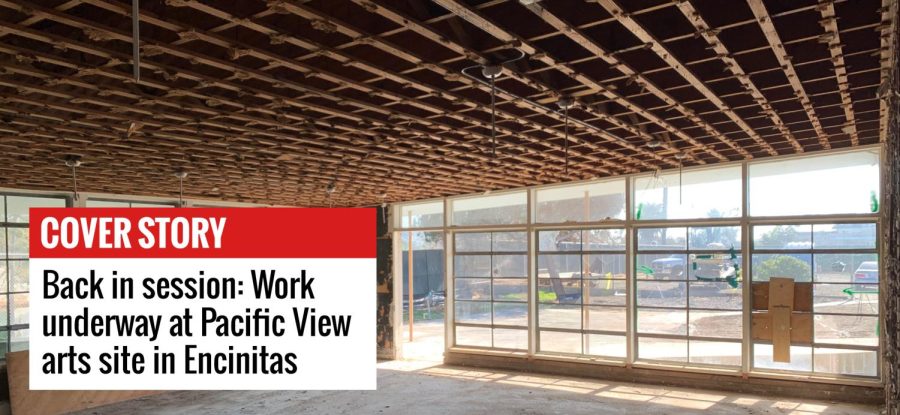Back in session: Work underway at Pacific View arts site in Encinitas
After years of meetings, advocacy and planning, the former Pacific View Elementary School is on the way to becoming a center of activity again.
On Oct. 26, 2022, the Encinitas City Council announced that Conan Construction won the bid to renovate the site, with Kleinfelder Construction Services managing and inspecting.
The total cost will be $6,466,400, which comprises a construction contract of $4,559,500, construction contingency at $911,900, construction management and inspection at $800,000, construction management and inspection contingency at $120,000, and utility company fees of $75,000.
The former school, located at 608 Third St., was built in 1953 and closed in 2003 due to decreased enrollment. In early 2014, it was put up for public auction.
“I remember waking up at 3 a.m. in February of 2014, and it occurred to me that (the) grown-ups aren’t going to fix this,” resident Scott Chatfield recalled. “I remember thinking, ‘This shall not stand.’”
As a result, Chatfield created savepacificview.org, which has served as a central source of information on the project.
A few months later, the city decided to purchase the property, securing its use within the public domain.
Bringing the 70-year-old structure up to date will take some time. Work began on Nov. 28, 2022, and is expected to be complete by May 24, 2024. A city spokesperson confirmed that the project is currently on schedule.
“Initial efforts consisted of demolition and abatement of hazardous materials,” said the spokesperson, who declined to be named. “Construction of the building improvements began in January 2023.”
Along with repairing structural elements damaged by termites and weather, new roofs will also be constructed for both buildings. Other improvements include adding shear walls and foundations to meet current building codes, building ramps and a wheelchair lift to meet Americans with Disabilities Act compliance, replacing old plumbing and electrical systems, adding an HVAC system, and integrating an electronic fire protection system and industrial technology system.
The site will primarily be used for arts education, including visual, performing, literary and music programs. There will also be drop-in times for artists to work on their projects.
“Each of the site’s classrooms is designed for an intended use,” the city spokesperson explained. “Some of the educational programmings may include printmaking, photography, drawing, painting, dance, theater, music, fiber arts, and other areas of community interest.”
Carolyn Cope, president of the Encinitas Historical Society, located on the same lot, said she is enthusiastic about the project moving forward.
“(It’s) a tremendous asset to the city and the neighborhood,” she said, sharing that the organization may expand its hours after the facility opens.
There have been debates along the way on how the site should be used. However, Encinitas Mayor Tony Kranz said he feels that this is common.
“It seems like we have a consensus for what we are doing, which is making buildings habitable and activating the site,” he said.
Once the work is complete, and the vision is solidified, he is confident about its benefits.

“I think this is another piece that will attract additional people downtown,” he said. “It’s got the historical aspects as well as the cultural aspects that I think people in this region appreciate.”
Encinitas Friends of the Arts has aided in fundraising and advocacy throughout the project’s journey. Though the city’s Cultural Arts Division will manage the site, Naimeh Woodward, founder and president of the Encinitas Friends of the Arts, said she is hopeful that the organization will still be a part of the conversation.
“We are excited for the project and would love to be engaged,” she said. “But, we are waiting for the city’s direction on how they want us to be involved.”
Woodward sees the center as a way of celebrating the diversity of Encinitas.
“Our goal is to really make it a destination,” she said, explaining that the site can be a stop as tourists take in local businesses, including art galleries and restaurants. “We want to bring in cutting-edge arts and bring in celebrated artists that live in our community.”
She added that she would enjoy seeing fiber art classes offered as well as an integration of science into the programs.

“There’s a lot of exciting things they can choose to do. They’ll need help. We are here to support them the best we can,” she said.
In the meantime, the community can provide input through surveys and by attending meetings.
“Public input will be obtained through future surveys and the Commission for the Arts public meetings that are noticed on the city website,” the city spokesperson said.
They shared that focus groups consisting of community members and Commission for the Arts members have already provided feedback on the facility’s color, programming and fundraising.
After a long journey and uncertainties along the way, the mood is optimistic.
“(It’s) very gratifying,” Kranz said. “The process has been long and sometimes difficult to be patient about, but thanks to my colleagues on the council and previous Mayor Catherine Blakespear, we took some important steps, and solid progress is now made.”
“I’m so proud of our City Council because it was a brave thing to do,” Chatfield said. “They put their money where their mouth was and took a lot of flak for their view. I think history will prove that their vision was magnificently justified.”
Charlene Pulsonetti is a local freelance writer.



